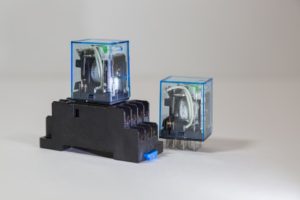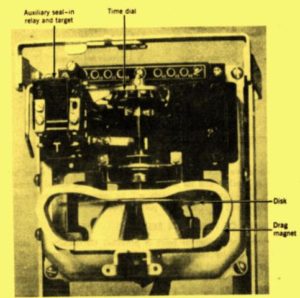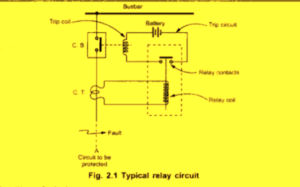What is Relay?
A relay is a device that opens and closes an auxiliary circuit under predetermined conditions in the main circuit.
Relays are extensively used in electrical, electronics engineering, and many other fields. There are relays that are sensitive to conditions of current, voltage, temperature, frequency, or some other combination of these conditions.
The need for Relay
All the electrical power system always requires a continuous supply of electrical power without any interruption to the load which is connected to the electrical power system.
A short circuit fault or shut fault is one of the sources of interruption of power supply in the system which produces a sudden and sometimes violent change in the system.

Abnormal conditions like faults in an electrical circuit and operates automatic switchgear to isolate faulty equipment from the system as quickly as possible are detected by a protective relay and protecting system. In this way, it operates to protect the power system supply circuit.
Historical Background:
In the early days of the power industries, small generators were used to supply local loads, and fuses were used as protection devices to isolate the faulty equipment from the circuit.
And these fuses were effective and their performance was quite satisfactory for small systems.
But these protection devices suffered from the disadvantages of requiring replacement before the supply could be restored and frequent interruption in the power system supply for any important lines is undesirable.
This undesirable condition was overcome with the introduction of circuit breakers and protective relays.
At first, finely made “Swiss watch” precision electromagnetic relays were developed and installed hundreds of years ago.
In the 1970s, electromagnetic relays were replaced by the availability of solid-state or static relay with a slight change in relay function. Here solid-state relays have no communication or event recording functions.
The widespread growth of computer technology in the 1970s resulted in the introduction of a microprocessor-based numeric or digital relay.
This first generation of the digital relay brought innovation in developing new algorithms and the beginning of combining several protection functions in one multifunctional relay.

The initial operation of the first-generation numeric relays was based on ASCII protocol or proprietary serial commands but the relay manufacturers later developed graphical user interface software for the generation of background serial commands to program the relay elements.
Now, these relays are not used and reached to end of their service life as this situation is the through-hole component mounting design and poor solder joints.
Heating and cooling of the circuit board also lead to problems such as bad connection and failure of electrolytic capacitor in the power supply.
The first generation numeric relays are equipped with built-in test routines that signal and alarm output, operators known when the numeric relay fails.
This built-in test routine did not present in the electromagnetic relay and most solid-state relays design.
The new technology second-generation numeric relays are equipped with more powerful microprocessors and are more reliable surface-mount construction, and also has improved algorithms and elements.
These new protection schemes provide a more reliable, more secure, and more dependable operation.
Essential Qualities of Protection
The basic needs of a protective system are as follows:
- Selectivity or discrimination
- Sensitivity
- Reliability
- Stability
- Fast operation
Selectivity
Selectivity is the quality of a protective relay due to which it is able to discriminate between the normal condition and a fault in the protected section. It is also able to distinguish whether a fault lies within its zone of protection or outside the zone of protection.
Sometimes, this quality of the protective relay is also called discrimination. The protective relay should also be able to differentiate between a fault and transient conditions like power surges or the inrush of a transformer’s magnetizing current.
The relay should be able to discriminate between a fault or power surge either by its inherent characteristic or with the help of an auxiliary relay.
Thus we see that protective relays must be able to discriminate between those conditions for which instantaneous tripping is required and those for which no operation or a time-delay operation is required.
Sensitivity
When the magnitude of the current exceeds the preset value called the pick-up current then the relay will operate. The relay will not operate when the magnitude of the current is below its pick-up value.
The protective relay should be quite sensitive to operate when the operating current just exceeds its pick-up value.
Reliability
When a fault occurs in its zone of protection a protective relay or a protective system must operate reliably. Failure of a protective system may be due to the failure of one or more elements that are present in the protective system.
Some of the important elements of the protective system are the protective relay, circuit breaker, voltage transformer, current transformer, wiring, etc.
To attain a high degree of reliability greater attention should be given to the design, installation, maintenance, and testing of the various elements of the protective system.
From the reliability point of view contact pressure, contact material of the relay, and the prevention of contact contamination are also very important. For a protective system typical value of reliability is 95%.
Stability
A protective system should remain stable even when a large current is flowing through its protective zone due to an external fault, which does not lie in its zone.
Here the concerned circuit breaker is supposed to clear the fault. But the protective system will not wait indefinitely if the protective scheme of the zone in which fault has occurred fails to operate.
Then after a preset delay, the relay will operate to trip the circuit breaker to protect the system.
Fast operation
A protective relay or a protective system should be fast enough to faulty equipment from the system as quickly as possible to minimize the damage to the equipment due to the fault and to maintain the stability of the system.
For a modern power system stability criterion is very important and hence the operating time of the protective system should not exceed the critical clearing time to avoid the loss of synchronism.
The operating time for a relay is usually one cycle. While the operating time for a distribution system may be more than one-half cycle.
Working of a Relay
All the relays used for the protection of short circuit fault or shut fault operates by virtue of the voltage or current or both supplied to relays by the current transformer or potential transformer.

A relay mainly works on the principle of either electromagnetic attraction or electromagnetic induction.
A plunger is drawn into a solenoid or an armature is attracted to the poles of an electromagnet of an electromagnetic induction relay.
Such relays can be operated either by ac or dc. In the case of electromagnetic induction relays, the principle of induction motor is used and the torque is developed by electromagnetic induction. Such relay operates only on ac quantities.
